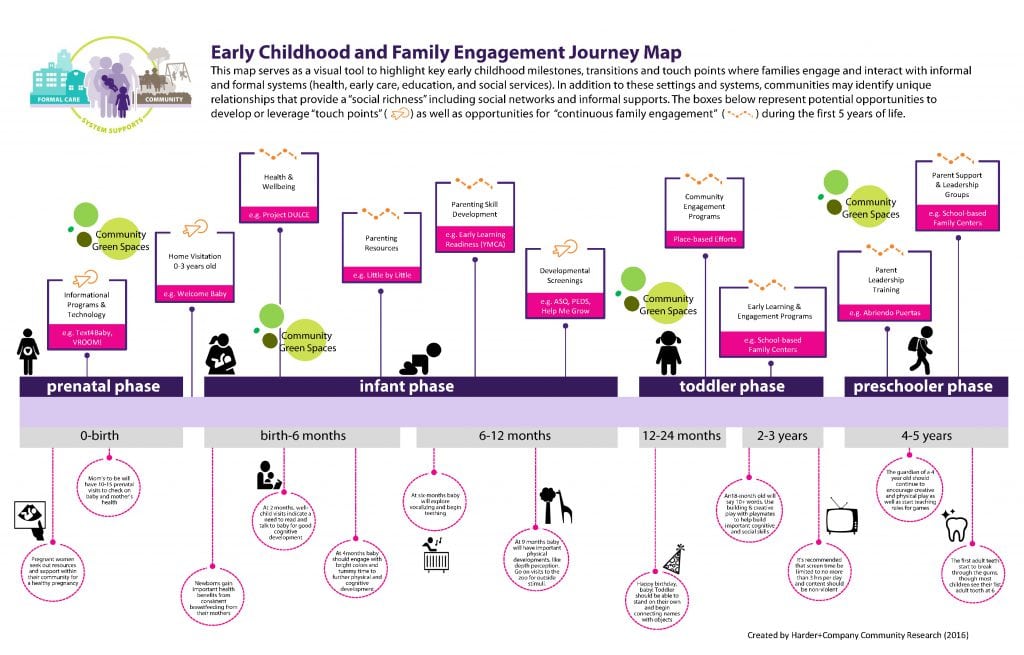
There is growing interest in the social sector in ways to use design thinking techniques to improve programs and systems. As part of our ongoing early childhood work in the Los Angeles region (see our earlier post about the report, Family at the Center), we recently used journey mapping to explore ways that families engage with systems and social supports along the birth to five continuum. Journey mapping is a tool to analyze and improve how customers engage with a particular product or service. If you google journey mapping, you’ll find lots of examples of internet and consumer product companies—from YouTube to Best Buy—using journey mapping to analyze the customer experience. We also see how journey mapping can be a powerful tool in the social sector to explore the experience of people who interact with programs, services, and systems.
Over the last two years, our work with diverse early childhood advocates in Los Angeles County revealed a need for better alignment and coordination among local and regional stakeholders focused on family engagement. We identified many different programs, initiatives, and opportunities throughout the county that could be woven together across community, early care, and health care settings. But we also heard about disconnects between families and providers that keep families from accessing these important services.
As our partners at the David and Lucile Packard Foundation, First 5 LA, and the LA Partnership for Early Childhood Investment grappled with how to address the issue in a meaningful way, we proposed stepping back and viewing the issue from the families’ perspective. How do LA’s diverse families—particularly those in low-income and under-resourced communities—experience the labyrinth of programs, systems, and multiple transitions during the first five years of their child’s life?
To answer that question, we created a family engagement journey map. While we recognized the complexity of what we were trying to map, this simple depiction of families’ experiences with the early childhood system brought clarity to our conversations and helped us identify and better communicate opportunities and barriers.

Journey maps can tell a story by documenting the stakeholder experience or re-imaging what an ideal experience might look like. They are not intended to map every twist and turn or capture every aspect of the experience—the goal is to understand and strengthen how people experience a given service, program, or system. Here are several compelling reasons you might consider using journey mapping as a tool for tackling issues you care about:
- Focusing on client-centric and human-centered solutions: During our earlier work on family engagement, Los Angeles stakeholders emphasized that effective family engagement means putting families front and center. Journey mapping helped keep us grounded in the family experience. The journey map – and the illustration of a growing child leaping across the page – reminds us what this work is all about and helps lead us to more family-centered solutions.
- Identifying opportunities and early entry points: It’s easy to get caught up in complex and daunting discussions about systems building, community change, and the ultimate outcomes we seek. Journey mapping can bring us back to the more fundamental questions about how individuals are experiencing a particular issue or problem. As we grappled with the magnitude of need and wondered where to begin, the journey map helped us identify some ready entry points to build momentum for aligned and coordinated family engagement in Los Angeles County.
- Engaging stakeholders in exploring new pathways and possibilities: As we began to build our family engagement journey map, we grappled with what the journey actually looks like and what it could look like if circumstances were different and supports were in place. Both versions are important, and the journey map will likely look different depending on the community context. Furthermore, engaging other stakeholders in the thought-provoking process of developing the map is a great way to explore and re-imagine ways to make the journey rewarding and fruitful.
During the last six months we’ve had the opportunity to share our journey map with other organizations, funders, and collaboratives working to improve outcomes for young children and families. Much to our delight, the journey map generated considerable interest. Many people have recognized how the basic process of mapping programs, services, and systems can shed light on both gaps and opportunities in their communities. While our family engagement journey map is still a work in progress, the process was enlightening for all stakeholders and illustrates the value of this tool in the social sector.
